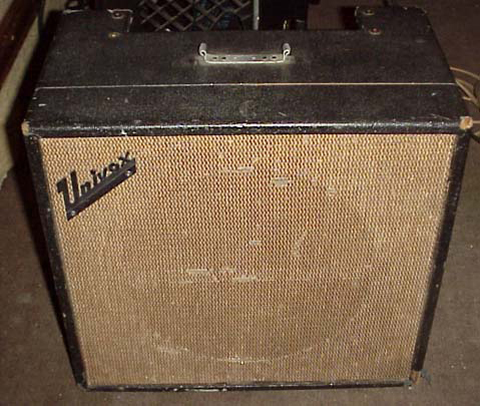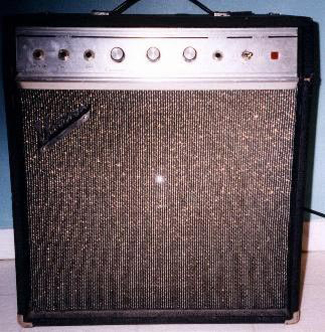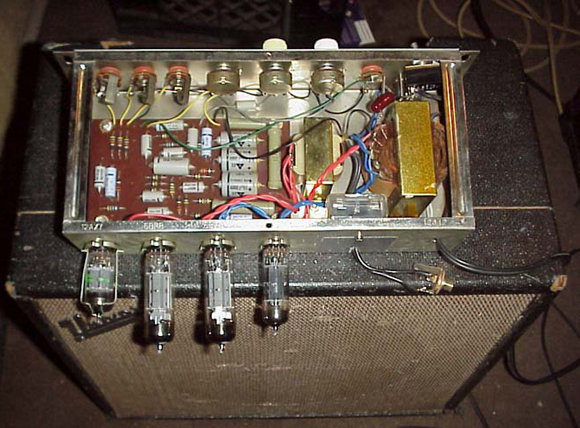A lot of yesterday’s “sleeper” amps, the great secret tone machines that only a few gear-geeks knew about (such as Danelectros and the several-branded versions of Valcos—Supro, National, Airline and the like) are now pretty well known and, as a result, are not as cheap as they were say, ten years ago. But there are still some great deals to be found with some of the other lesser-known amps of the 60’s and 70’s.
Among the best deals out there are the Japanese-made Univox tube amps of the mid to late 60’s. There are some rare birds out there that are worth keeping an eye open for, but the one you see most often, among the low-priced, great sounding Univox tube amps, is the U-45B Model.

1960's Univox Guitar Amplifier
This is a small, incredibly light, and super simple and easy to work on amp that has a great garage and blues tone all its own. What’s not to love? And, while it does employ some oddball tubes, they are readily available and not at all expensive like some of the less common tubes from 1960’s amplifiers.
So, what’s going on with the U-45B? It actually has a lot to recommend it beyond some of the other cheaper vintage amps. The cabinet is solid, and the baffle is made of plywood, unlike, say the cheesy pressboard in an otherwise great amp like the Danelectro-made Silvertone 1482. So, you’ve got, in the U-45B, a fine Jensen 12” speaker that fits tightly and without rattle against some nice solid wood. A nice surprise in a cheapy. Also, the tolex (or whatever tolex-like material is used) on the later, front-controlled version of the U-45B is pretty durable, unlike some of the nice colored paper you might get on some Valco and Dano products.
The tube line up of the amp is the rather unusual 12AX7, 6BM8, 6BM8, 6X4. It’s rated at 10 watts. The 6X4 is an easy to find rectifier. What’s odd about this amp is that the 12AX7 isn’t used as a preamp tube but, rather, as the tremolo tube. The less common 6BM8s are used as both preamp and output tubes.

1960's Univox Guitar Amplifier
The control panel (on the top in early 60’s versions, on the front in later models—otherwise, they are the same amp) is about as simple as it gets. VOLUME. TONE and SPEED (for the tremolo, which has a nice deep set depth).
How does it sound? Well, pretty great. You can get some very fine clean tones when the volume is under half way, from a jazzy laid-back tone, to a twangy rockabilly sound. It’s great for recording. A quiet, smooth sounding amp on its clean settings, but where it really comes alive is when it’s pushed into overdrive. At 10 watts, with a 15 watt Jensen 12”, it really excels for recording rock guitar or for a quiet(er) jam with full-throttle tone. It’s around 15 lbs, yet it’s built solidly and it sounds great. It’s an amp you want, and you can find them, with stunning regularity, for under $250…frequently for a good deal less.

1960's Univox Guitar Amplifier
The tremolo is rich, with a nice range of speeds. The only possible downside to the amp? It has a rather dark voice which offers plenty of sparkle while using a Tele, but it can muddy up a bit with a darker voiced guitar like, say, a Supro Dual Tone. An easy, non-mod fix for this? Any boost pedal gives it plenty of sparkle. (My home-made OC71 Germanium boost gives it a rich, harmonic sparkly push…awesome). But if you want to totally retain the tone of the amp and the voice of the guitar, use a simple EQ pedal, and you can dial in a little more treble, while keeping the basic character of the amp.
This is a great amp. It was also (with the exact same components from the same factory) marketed/labeled as a Lafayette, a Cavalier—and also marketed by the Hilgen brand under the model name Meteor. Most Hilgens I’ve seen (hardly a scientific sampling, but, still…) were made in New Jersey, but, for a time, the company apparently imported SOME of their amps, and the one I’ve seen the most of, among the imported Hilgens, is their Meteor branded amp that is the same, guts-wise, as the Univox U-45B.
So why haven’t these caught on in the vintage market? Who cares, but why not take advantage of it while they’re still cheap?
Next month—more on some of the even more rare Univox’s, like the U305 with the 15” speaker, or some of the more rare 2X10” amps with 6973 output tubes and more! Meanwhile, search away.

I just bought one of these from a friend of mine and love it. He told me it sounded terrible, and was willing to get rid of it for $45 bucks. best buy I’ve ever made!
wow, I’m 58 now and this was my first amp, wish i still had it. at that time i played a gibson melody maker with a sam ash fuzzola, and a vox wah wah (1968). just got the melody maker back, still have my original wah. your picture of this amp put a tear in my eye— thanks
Just bought one of these last night from Bob at Rhythm & Notes in Redondo Beach, CA for $280. Bob said he left it stock except replacing a couple of caps…it’s got the Jensen speaker, which sounds great. Definitely a practice/recording/bedroom amp…I don’t think you could gig with it, unless it’s a very mellow gig and the drummer uses brushes, etc. As Rob says, stays pretty clean up until about 5 on the volume…then it slowly gets more overdriven…and it is a fantastic overdrive sound! Also, Rob is correct in saying that it is a dark tone…not muddy, but it’s not very bright at all. It’s not the find of the century, but is this: a lightweight, simple, good (and sometimes great) sounding tube amp for under $300. So far I’m happy with it. Thanks!
I just got the front controlled amp and the univox hollow body guitar came with it. All I did was clean the pots and put some new tubes in and the result is AWESOME TONE!!!!! The guitar….. not so much. The trem does not work so I’ll have to get it fixed. Great amp!!!!!!
I now own three univox guitar amplifiers. They just keep showing up at very reasonable prices. I gig with one or two (ran together) univox U202R’s they are about 20+watts each and sound warm and brown clean and bluesy when turned up. I always revoice them with my own selection of speakers because I found the original Japanese Alnico to sound way too thin.
Number three is a univox U-45B I just bought out of Portland from an amp tech had to pay the most yet $225. This has become the living room amp for practice and when friends stop by and I love it’s tone. Real clean at three and dirty but not deluxe muddy when dime’d. It came with a celestiom G-12L 35 which seems to sound o.k.
Is this the same Univox as the one in the mid 70’s that made, at least as far as their wah pedals go, equipment of rather questionable quality? I once saw Jeff Beck (Beck, Bogert and Appice) and he was using Univox amps. I recall they sounded okay, but who knows if they were stock or not. The concert went downhill when Beck started using the dreaded voice-box, doing the “put your hands together” shtick. I’m sure the voice-box has its fans, besides Peter Frampton, but I must recuse myself from that group . . .
I recently acquired a 60s univox amp with top mount controls (volume, tone, speed). 3 inputs and a foot switch jack. Square red light next to the on off switch, all controls and switches and light in line. Has 2 10 inch Jensen speakers…anyone have any info on this amp?
There used to be advertisements in a major guitar magazine with the huge Univox’s stacks that Zepplin used also Beck.
There is also a site that is dedicated to strictly Univox guitar & amps including the Univibe. Just Google up Univox and you should find it. Has the price lists, model number and all of everything they made. They were pretty descent gear that a lot of pros used. Company by Unicord also distributor for Marshall amps in U.S.A.
October 2014 (6 years after article is written). I found one of these at a local music shop for $350. I can honestly say to me it sounds better than any chamfer Viber a champ I have run across. What an amazing little amp. That 12 inch Jensen speaker probably doesn’t hurt much either.
I have a Univox U60.GR electric guitar amp that I can’t seem to find any information on, it looks different than any other Univox I have seen, can anyone tell me anything about this amp.
My older brother bought a top mount control ‘Lafayette Radio Electronics’ branded version of this amp new in 1964 or so. We still have it! Sounds great cranked with a Dan-O plugged into it! My only complaint is the internal mounting of the fuse which requires removing the back plate to gain access.
Actually, only 1/2 of the 12AX7 is used for the tremolo, with the other triode serving the usual duty as the first stage of the preamp. the second preamp stage is, indeed, the triode section of one of the 6BM8s, with an unusually high (470k) plate resistor, but the second one is configured as a cathodyne phase inverter. A very clever setup IMO. I’ve studied this circuit in some depth since EH started producing the 6BM8 tubes, which are extremely versatile. I have built several similar amps, but without tremolo, using either paralleled 12AX7s in the first spot, cascoded 12AX7s, or and EF86. All sound very good. Have also made a usable 1-tube practice amp with just the triode section serving as a preamp and the pentode section the power amp. FWIW, the triode section is roughly equivalent to a 12AY7 and the pentode section is like an EL82 (smaller cousin to the EL84.)
I love this website. I just recently purchased a 1969 Univox Model 1076 p.a. Head. It says 200 watts on the back of the amp. It is equipped with 4 6L6’s , three 12ax7’s and a 12au7 for the phase inverter and not a circuit board in site. The middle aged lady that posted it on a local letgo site said she was a “budding “ interior decorator that had plans to screw a lamp to the top of it and stage it in a music room of an upcoming open house!!!! Thank god her services were not needed. And I paid 30.00 dollars for it. I kinda felt bad until I got it home and plugged it into a variac that had a current limiter in-line with it. Checked out ok.
I then pulled the chassis and opened it up. Bone stock. I changed all of the old Japanese cap. Then plugged it into a 4×12. OMG. Cleanest amp I ever played. Tons of headroom. I have had people tell me I should plug a distortion pedal into it and rock on. I have looked all over the internet to find a picture and cannot find one except on vintage univox.com. Are these amps collectible? Have I done a disservice by changing the caps and 2prong power cord? It has 4 inputs , 8 total high and low. Should I jump the channels to get it to distort? Maybe someone can give me some feedback at jackmatthews65@yahoo.com. Thanks
I’m needing to replace the potometers on my Univox
Not sure if it’s a U42, U44, or U45. I’m interested in part numbers. Thanks.
I’m Justin Wilson from Alabama
2044571149.